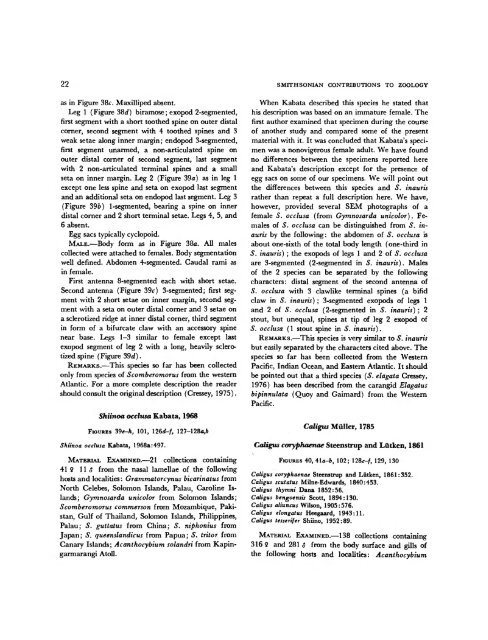Parasitic Copepods of Mackerel - and Tuna-like Fishes (Scombridae ...
Parasitic Copepods of Mackerel - and Tuna-like Fishes (Scombridae ...
Parasitic Copepods of Mackerel - and Tuna-like Fishes (Scombridae ...
You also want an ePaper? Increase the reach of your titles
YUMPU automatically turns print PDFs into web optimized ePapers that Google loves.
22 SMITHSONIAN CONTRIBUTIONS TO ZOOLOGY<br />
as in Figure 38c. Maxilliped absent.<br />
Leg 1 (Figure 38rf) biramose; exopod 2-segmented,<br />
first segment with a short toothed spine on outer distal<br />
corner, second segment with 4 toothed spines <strong>and</strong> 3<br />
weak setae along inner margin; endopod 3-segmented,<br />
first segment unarmed, a non-articulated spine on<br />
outer distal corner <strong>of</strong> second segment, last segment<br />
with 2 non-articulated terminal spines <strong>and</strong> a small<br />
seta on inner margin. Leg 2 (Figure 39a) as in leg 1<br />
except one less spine <strong>and</strong> seta on exopod last segment<br />
<strong>and</strong> an additional seta on endopod last segment. Leg 3<br />
(Figure 39b) 1-segmented, bearing a spine on inner<br />
distal corner <strong>and</strong> 2 short terminal setae. Legs 4, 5, <strong>and</strong><br />
6 absent.<br />
Egg sacs typically cyclopoid.<br />
MALE.—Body form as in Figure 38a. All males<br />
collected were attached to females. Body segmentation<br />
well defined. Abdomen 4-segmented. Caudal rami as<br />
in female.<br />
First antenna 8-segmented each with short setae.<br />
Second antenna (Figure 39c) 3-segmented; first segment<br />
with 2 short setae on inner margin, second segment<br />
with a seta on outer distal comer <strong>and</strong> 3 setae on<br />
a sclerotized ridge at inner distal corner, third segment<br />
in form <strong>of</strong> a bifurcate claw with an accessory spine<br />
near base. Legs 1-3 similar to female except last<br />
exopod segment <strong>of</strong> leg 2 with a long, heavily sclerotized<br />
spine (Figure 39d).<br />
REMARKS.—This species so far has been collected<br />
only from species <strong>of</strong> Scomberomorus from the western<br />
Atlantic. For a more complete description the reader<br />
should consult the original description (Cressey, 1975).<br />
Shiinoa occlusa Rabat a, 1968<br />
FIGURES 39e-h, 101, \2U-f, 127-128a,fc<br />
Shiinoa occlusa Kabata, 1968a:497.<br />
MATERIAL EXAMINED.—21 collections containing<br />
41 9 11 $ from the nasal lamellae <strong>of</strong> the following<br />
hosts <strong>and</strong> localities: Grammatorcynus bicarinatus from<br />
North Celebes, Solomon Isl<strong>and</strong>s, Palau, Caroline Isl<strong>and</strong>s;<br />
Gymnosarda unicolor from Solomon Isl<strong>and</strong>s;<br />
Scomberomorus commerson from Mozambique, Pakistan,<br />
Gulf <strong>of</strong> Thail<strong>and</strong>, Solomon Isl<strong>and</strong>s, Philippines,<br />
Palau; S. guttatus from China; S. niphonius from<br />
Japan; S. queensl<strong>and</strong>icus from Papua; S. tritor from<br />
Canary Isl<strong>and</strong>s; Acanthocybium sol<strong>and</strong>ri from Kapingarmarangi<br />
Atoll.<br />
When Kabata described this species he stated that<br />
his description was based on an immature female. The<br />
first author examined that specimen during the course<br />
<strong>of</strong> another study <strong>and</strong> compared some <strong>of</strong> the present<br />
material with it. It was concluded that Kabata's specimen<br />
was a nonovigerous female adult. We have found<br />
no differences between the specimens reported here<br />
<strong>and</strong> Kabata's description except for the presence <strong>of</strong><br />
egg sacs on some <strong>of</strong> our specimens. We will point out<br />
the differences between this species <strong>and</strong> S. inauris<br />
rather than repeat a full description here. We have,<br />
however, provided several SEM photographs <strong>of</strong> a<br />
female S. occlusa (from Gymnosarda unicolor). Females<br />
<strong>of</strong> S. occlusa can be distinguished from S. inauris<br />
by the following: the abdomen <strong>of</strong> S. occlusa is<br />
about one-sixth <strong>of</strong> the total body length (one-third in<br />
S. inauris) ; the exopods <strong>of</strong> legs 1 <strong>and</strong> 2 <strong>of</strong> S. occlusa<br />
are 3-segmented (2-segmented in S. inauris). Males<br />
<strong>of</strong> the 2 species can be separated by the following<br />
characters: distal segment <strong>of</strong> the second antenna <strong>of</strong><br />
S. occlusa with 3 claw<strong>like</strong> terminal spines (a bifid<br />
claw in S. inauris); 3-segmented exopods <strong>of</strong> legs 1<br />
<strong>and</strong> 2 <strong>of</strong> S. occlusa (2-segmented in S. inauris); 2<br />
stout, but unequal, spines at tip <strong>of</strong> leg 2 exopod <strong>of</strong><br />
S. occlusa (1 stout spine in S. inauris).<br />
REMARKS.—This species is very similar to S. inauris<br />
but easily separated by the characters cited above. The<br />
species so far has been collected from the Western<br />
Pacific, Indian Ocean, <strong>and</strong> Eastern Atlantic. It should<br />
be pointed out that a third species (S. elagata Cressey,<br />
1976) has been described from the carangid Elagatus<br />
bipinnulata (Quoy <strong>and</strong> Gaimard) from the Western<br />
Pacific.<br />
Caligus Muller, 1785<br />
Caligus coryphaenae Steenstrup <strong>and</strong> Liitken, 1861<br />
FIGURES 40, 41a-6, 102; 128c-/, 129, 130<br />
Caligus coryphaenae Steenstrup <strong>and</strong> Liitken, 1861:352.<br />
Caligus scutatus Milne-Edwards, 1840:453.<br />
Caligus thymni Dana 1852:56.<br />
Caligus bengoensis Scott, 1894:130.<br />
Caligus aliuncus Wilson, 1905:576.<br />
Caligus elongatus Heegaard, 1943:11.<br />
Caligus tesserifer Shiino, 1952:89.<br />
MATERIAL EXAMINED.—138 collections containing<br />
316 9 <strong>and</strong> 281 $ from the body surface <strong>and</strong> gills <strong>of</strong><br />
the following hosts <strong>and</strong> localities: Acanthocybium

















